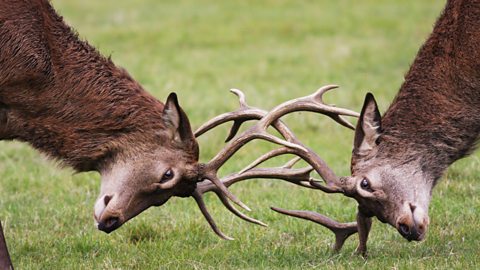Competition
Competition in plants
Light
All plants and algae need light to photosynthesisA chemical process used by plants to make glucose and oxygen from carbon dioxide and water, using light energy. Oxygen is produced as a by-product of photosynthesis. Algae subsumed within plants and some bacteria are also photosynthetic.. Plants compete for light by growing quickly to reach it and often shade other plants with their leaves. When an old tree in a forest dies and falls to the ground, there is a race to fill in the gap in the canopy. It doesn't look like a race to us because it happens slowly.
Water from the soil
Water is a reactant in photosynthesis and it is essential that plants have a regular supply of water for the process to occur. Some fully grown trees, like the oak tree, lose a staggering 150 litres of water per day, which is used to transport materials through the plant to the leaves. Some plants have roots that are shallow but extend a long way from the tree to maximise the update of water after rainfall. Others have roots that are deep to find stores of underground water.
Minerals from the soil
Plants require minerals for healthy growth. These include nitrateThe chemical absorbed from the soil by plants to produce their protein. and magnesium. Without sufficient minerals, plants suffer deficiencyIn the diet, a deficiency happens if there is too little of a particular nutrient. diseases because they cannot grow healthily. Plants that grow in soils with few minerals, such as bogs, have evolved different ways of accessing nitrates. Some, like the Venus flytrap and pitcher plants, have evolved to absorb nitrogen compounds from the insects they trap, enabling them to grow more successfully than their competitors on mineral poor soil.
Space
Plants also require space for healthy growth. This means their leaves are not shaded which maximises photosynthesis. Some gardeners have experimented by planting vegetables very close together. These result in much smaller vegetables being produced.
Plants also compete for pollinators, and seed dispersers.
Competition can be intraspecific competitionThe competition between organisms within the same species., for example competition between oak trees in a forest, or interspecific competitionThe competition which occurs between organisms of different species for a common resource. such as when another speciesA type of organism that is the basic unit of classification. Individuals of different species are not able to interbreed successfully. of tree like birch or yew grew next to oak trees. When a woodland tree dies, other younger trees compete to replace it. This competition ensures the growth of the healthiest individuals, and maintains vigour in the population.
Individuals within a species that cannot compete effectively are unlikely to reproduce, and may die. This is known as survival of the fittest and is a driver for theory of evolutionA theory put forward by Charles Darwin that all living creatures that exist today, including human beings, have evolved over a period of millions of years from more primitive life forms.. Whole species that are unable to effectively compete may become extinctA species that has completely died out..
Competition in animals
Food
All animals require food which provides them with energy and raw materials to complete life processesThe key reactions that all living organisms complete.. Because of this, competition for food can be fierce. There are many birds that eat insects in our gardens, and some have evolved to only eat certain types of insect to reduce competition from other speciesA type of organism that is the basic unit of classification. Individuals of different species are not able to interbreed successfully.. Others like the blue tit and great tit compete with other members of their own species. Because food is so vital, many animals will fight for it.
Mates

Animals within a species also compete for mates. This is essential so they can pass on their geneThe basic unit of genetic material inherited from our parents. A gene is a section of DNA which controls part of a cell's chemistry - particularly protein production. to their offspring. Animals have evolved an innate or natural drive to reproduce, and this competition often results in fights. This is seen each year when animals like red deer group together at the start of the rutting (mating) season. Large male deer fight with each other by locking antlers and pushing hard. In deer, and many others species, these fights competing for mates can often result in serious injury or death, but benefits the population as only the strongest pass on their genes to the next generation.
Territory
The territories of animals contain all of the resources and conditions they need to survive. These include abioticNon-living elements of an ecosystem, such as climate, temperature, water, and soil type. factors such as light, warmth and water, and oxygen for aquatic animals. There are also bioticLiving elements of an ecosystem, such as plants and animals. factors such as food and predators. Many animals, including the cats in back gardens, will fight for territory.
An example of intraspecific competition over territory would be between lions on the grass plains of Africa whereas interspecific competition would occur when another predatorAn animal that hunts, kills and eats other animals for food. like leopards lived close to the lions.
More guides on this topic
- What happens during photosynthesis? - OCR 21st Century
- How do producers get the substances they need? - OCR 21st Century
- How do producers transport substances they need? - OCR 21st Century
- How are organisms in an ecosystem interdependent? - OCR 21st Century
- How are populations affected by conditions in an ecosystem?
- Sample exam questions - living together - OCR 21st Century